Seagate BarraCuda Pro 14TB HDD Review: Massive Storage for Desktops
by Ganesh T S on September 10, 2018 8:01 AM ESTPerformance - Internal Storage Mode
The performance of an internal storage device is dependent on the performance characteristics of the device as well as the file system being used. In order to isolate the effects of the latter, we first benchmarked the raw drives using HD Tune Pro 5.70. It was then formatted in NTFS and subject to our standard direct-attached benchmark suite.
Raw Drive Performance
HD Tune Pro allows us to run a variety of tests to determine transfer rates and IOPS for various artificial workloads. In addition, it also allows us to visualize how the performance varies as the tracking head moves from the outer parts of the platter towards the center (i.e, transfer rates as a function of the block address).
Empty drives are bound to perform very well, but, depending on the location of the data in the drive, we find that access rates can go as low as 117 MBps for sequential workloads (compared to the 112 MBps of the 12TB drive from last year). Write access times are a bit unpredictable due to the multi-segmented cache.
Random accesses are never the strong points of hard drives, and we see that the BarraCuda Pro delivers around 69 IOPS for 4K random reads and 222 IOPS for 4K random writes. The random read performance is very similar to the performance of the 12TB version from last year, while the random write performance receives a boost up from 191 IOPS.
The extra tests help in putting some numbers to sequential accesses targeting different areas of the drive. It also provides some interesting numbers relevant to various random access workloads.
DAS Benchmarks
Consumers opting for drives such as the 12TB Seagate BarraCuda Pro typically need high-capacity local storage for holding and editing / processing large-sized multimedia files. Prior to taking a look at the real-life benchmarks, we first check what CrystalDiskMark has to report for the drive. The numbers are in the same ballpark as the 12TB version from last year.
In order to tackle the real-life use-case of transferring large amounts of data back and forth from the drive, we created three test folders with the following characteristics:
- Photos: 15.6 GB collection of 4320 photos (RAW as well as JPEGs) in 61 sub-folders
- Videos: 16.1 GB collection of 244 videos (MP4 as well as MOVs) in 6 sub-folders
- BR: 10.7 GB Blu-ray folder structure of the IDT Benchmark Blu-ray (the same that we use in our robocopy tests for NAS systems)
| Seagate BarraCuda Pro 14TB robocopy Benchmarks (MBps) | ||
| Write Bandwidth | Read Bandwidth | |
| Photos | 197.81 | 206.81 |
| Videos | 219.51 | 206.99 |
| Blu-ray Folder | 222.00 | 212.36 |
These numbers are better than the ones we obtained for the 10TB version from 2016, but, fall a little short of the performance of the 12TB drive from last year.
While processing our DAS suite, we also recorded the instantaneous transfer rates and temperature of the drive. Compared to typical disk drives, the write transfers show higher instantaneous speeds due to a combination of the firmware and the 256 MB cache inside the drive. However, sustained write rates are comparable to other high-capacity drives when the cache is exhausted. The temperature of the unit at the end of the transfers (more than 250GB of traffic) rose by less than 4C, pointing to the power-efficiency of the platform.
For the use-case involving editing of multimedia files directly off the disk, we take advantage of PCMark 8's storage benchmark. The storage workload is a good example of a user workload, involving games as well as multimedia editing applications. The command line version allows us to cherry-pick storage traces to run on a target drive. We chose the following traces.
- Adobe Photoshop (Light)
- Adobe Photoshop (Heavy)
- Adobe After Effects
- Adobe Illustrator
Usually, PCMark 8 reports time to complete the trace, but the detailed log report has the read and write bandwidth figures which we present in our performance graphs. Note that the bandwidth number reported in the results don't involve idle time compression. Results might appear low, but that is part of the workload characteristic.
| Seagate BarraCuda Pro 14TB PCMark8 Storage Benchmarks (MBps) | ||
| Write Bandwidth | Read Bandwidth | |
| Adobe Photoshop (Light) | 248.16 | 9.01 |
| Adobe Photoshop (Heavy) | 233.95 | 11.03 |
| Adobe After Effects | 89.93 | 8.73 |
| Adobe Illustrator | 202.41 | 8.47 |
Compared to the results from the 12TB drive last year, we find that the read workloads fare very similarly, but, the write workloads have a slight edge.


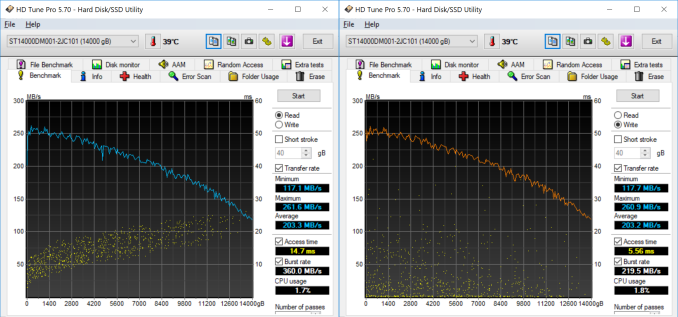
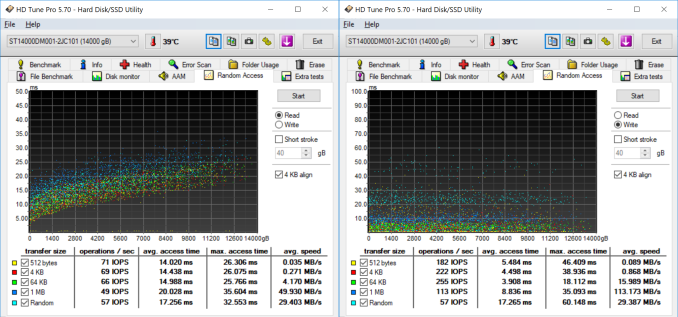
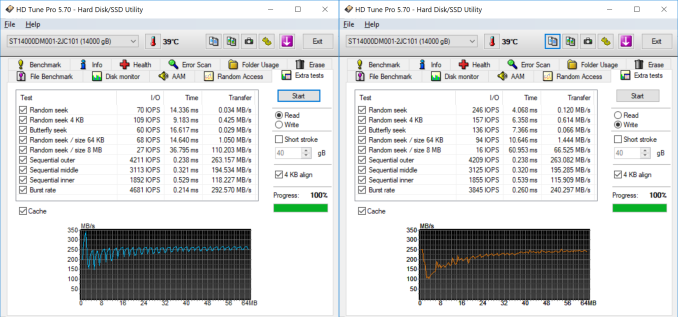
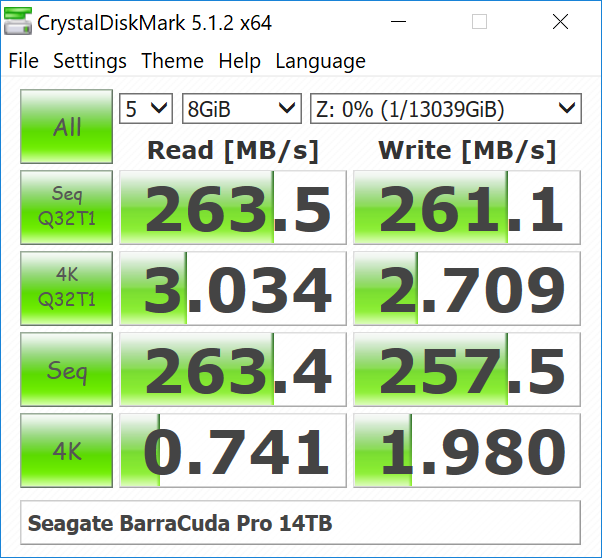
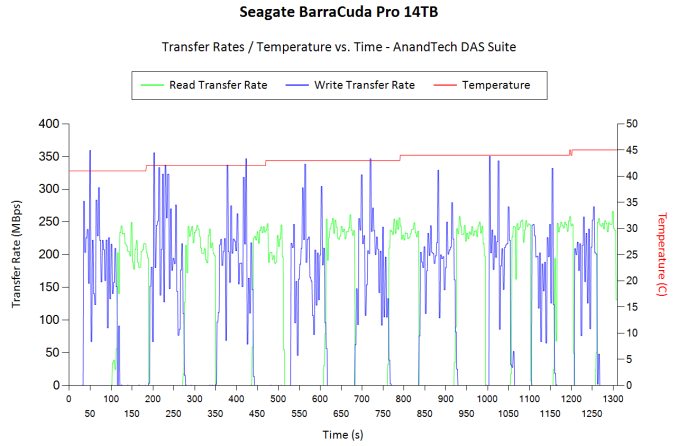








65 Comments
View All Comments
close - Monday, September 10, 2018 - link
It's not related to cost. Someone just knows RAID used to be a buzzword and he has to slip into the conversation to add weight to some dubious opinions.Seagate stands a lot better now reliability wise than it used to. Backblaze data seems to back this up. Drives don't "come" in RAID. You build it. Pretty sure he also goes for RAID 5 because it's "better", ""best performance/safety ratio".
bcronce - Monday, September 10, 2018 - link
RAID 5 and 6 don't protect from data corruption, just dataloss. ZFS has an custom implementation of RAID 5 and 6 that can detect corruption and figure out which source has an uncorrupted version.There are many other reasons than passive data corruption that can mess up your RAID 5/6.
wumpus - Tuesday, September 11, 2018 - link
Somehow I don't think I'm building a >40TB array with anything but ZFS (plus its own RAID).RAID is overblown and I'd expect more failures from things other than drives self-bricking. RAID's best feature is probably for yanking a drive due to SMART failures or aging out of an array. You'd have to take down a JBOD array to image a new drive from the one aged out. I wouldn't expect you to want to use the data from a drive yanked due to SMART failures. If you are just going to "build and forget" the array, RAID isn't buying you much.
If your network is up to it (it probably isn't), a good RAID should be able to handle the bandwidth of a large chunk of files being copied from an SSD (and easily should handle it if they are on the same computer, but that seriously limits your filesystem choices. Don't do that).
MrSpadge - Monday, September 10, 2018 - link
The value of data on a drive does not strictly depend on its size. Backup if it's important, don't if it's just temp storage or can easily be regenerated.Beaver M. - Tuesday, September 11, 2018 - link
Im running 2 12 TB not in RAID. Just using one of them as backup. Much safer than a RAID.No idea what youre talking about.
mapesdhs - Wednesday, September 12, 2018 - link
Are both drives in the same system? Hope you don't get a lightning strike. :}Just curious though, what's "safer" about doing it manually than simply using RAID1?
close - Thursday, September 13, 2018 - link
RAID 1 is the perfect way to ensure that any fcukup with the data on one drive is promptly replicated on the second one. In most normal cases performing a sync later is a much better option. A little more resistant to errors.eastcoast_pete - Monday, September 10, 2018 - link
Agree with others here that the list price is (way) too high, even for 14 TB. They need to bring that way down to be competitive on the price per Gb storage ratio.@Ganesh: Did you have a chance to ask Seagate about the reliability of these (very large) 'Cuda drives? Seagates Baracuda HDDs have had a, let's call it, "spotty" reliability over the last several years, also borne out in the survival stats at Backblaze. I would feel a lot more comfortable recommending these drives to customers if Seagate would be open about how they made sure that their drives are once again competitive with WD, Toshiba and, especially, HGST when it comes to reliability. A 5 year warranty is nice, but that means little if you end up spending days restoring > 7 TB from backups, which I hope you made frequently/daily. Remember, there are only two types of storage, regardless of technology: the one that failed, and the one that hasn't failed yet.
cjl - Tuesday, September 11, 2018 - link
Have you looked at any of the backblaze data in the past 2 years? The 6TB and up Seagates are doing excellently, as are the HGSTs, and WD is now the one trailing the pack. Obviously this one is too new to have any data yet, but the Seagate 6, 8, and 12TB drives are sitting around 1% AFR and the 10TB are down at 0.32% (though admittedly from a much smaller sample size - it looks like they pretty much skipped right over the 10TB generation and went straight for 12s, so the 10TB data is from only around a thousand drives).imaheadcase - Monday, September 10, 2018 - link
Kinda silly to run these in RAID for home use, especially since these sizes most likely be on a server and network will limit it anyways.